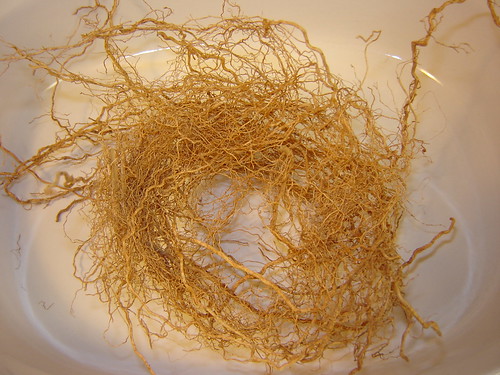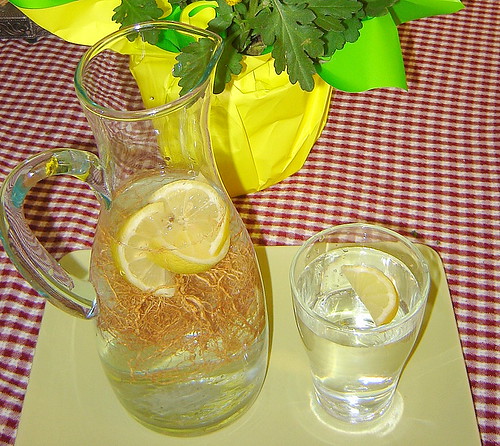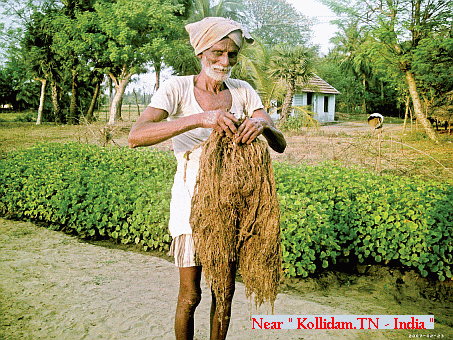Vetiver water
Summer is one of the hardest seasons in India. The average temperature has soared up atleast a few degrees Celcius in the past 10 ten years.
Smart ways to handle the heat are the ones that have been laid down by our ancestors. Local ingredients like tender coconut, palm fruits, gingelly oil, pearl onions, ragi porridge, fermented rice porridge has been in vogue to cool the body against the harsh heat.

At our home my father used to get a Kooja, a clay pot with narrow neck to store water. Water stored in clay pots have cooling effects on the body.
He would buy the clay koojas wash them so very well. Then he would pour boiled water to the kooja and add a small bundle of Vetiver root. Vetti means to cut and ver is root in Tamil. Leaving the root bundle in the water for a few hours and the water will get an acquired sweet smell and taste from the vetiver.
Vetiver (Chrysopogon zizanioides) is a perennial grass of the Poaceae native to India."Vetiver" name is native to Tamil language. Old Tamil literature mentions the usage of vetiver for medical purposes. Unlike most grasses which form horizontally spreading mat-like root systems, vetiver's roots grow downward up to 2-4 meters in depth.

Even now in universities and colleges, during summer when examiners are doing paper-correction for the year end finals, you can see halls having big thick vetiver mats on windows. Water will be sprinkled occasionally on these mats. The inside of the room will be very obviously cool and fragrant.
When my father came to visit me a few months ago, he got vetiver for me. A biggg bundle. Last weekend I recreated the vetiver water at home. Cool, crisp tasting with a citrus smell is what I would describe vetiver water as !!
Update: Nannari is a different kind of plant - roots and seeds are used in ayurveda and for preparing Sherbet. It is different from Vettiver. Its commonly called Indian Sarsaparilla (Hemidesmus indicus). More here on Wiki
Another picture of Vettiver from Mr Vasan, who is from Kollidam where Vettiver is grown and harvested.


43 Comments:
Good info Revathi. We really miss all these by staying away from home. The mild sweetness you get from these ver is so nice and you will drink water more really. We never bought the mineral water and mud pot water is so tasty always. Tks for reminding this valuable info Revathi. Viji
wonderfull info revathi! i never knew about this ver but ofcourse we also use the mud pot, cool water in the mud pots are divine.
Hello!
I am thinking of starting a new portal to host simple and easy-to-prepare recipes. This is mainly for bachelors/bachelorettes who may not have the time and the necessary utensils to prepare anything elaborate.
Please do contribute. For more details, I have made a post on this at:
http://cookingandme.blogspot.com/2007/05/portal-for-simple-cooking.html
Err.. does this comment look like spam? :O It really is not! Also, tell me what you think about the idea and better ideas of how I can go about this, if any.
Its been ages since I saw this root Revathi and it really made me nostalgic. We call it Waalaa in Marathi and also use it for the same purpose. I used to love drinking water from a clay pot (called Maath in marathi) with the fragrance and mild sweetness of Waalaa. This is one of the charms of a hot indian summer.
Never knew this Revathi.Great info.Thanks:))
Gosh you brought back some memories.....we used to add this to our earthen pots of water too,and we call it "vaalo" in Gujju.
trupti
This was a fascinating article Revathi. I would love to try this. So many wonderful Indian practices that are so healthy for the body.
WOW Wonderfull information... I have never tasted vativer water...will surly give it a try..
Revathi, I just found this in some enews and they have many of our blogs and posts without asking us(or me anyway!)I write personal things about kids etc which I don't want the whole world to see!What do you think?They have this post too.
http://www.enewss.com/Recipes/
It looks so beautiful in the glass pitcher, Revathi -- and what a fascinating drink! Your description makes me want a taste :)
Anupama, Trupti I was thinking using vetiver is only in tamilnadu. Truly an eye-opener to me.
Asha me too concerned with the external link !!
Ya you might find it in Malabar/Kerala groceries Linda !
Never tasted this!but now reading your post is making me wants to have some!
paati
hey, this is something i dont know , i have to aks mom about this , somehting really niceto know about. thanks for sharing it here.
-Pooja
cps says: very happy reva to know this. i saw your other preparations oin this site
Here is yet another Tamil heritage water delight. In a mud jaggu, you put vetti ver and also some sabja seeds over night. Morning, you see these sabja seeds bulged and with vettiver, they give very sweet aroma for your cold water. and these sabja seeds are, are nothing but Thiruneetrupatrigai seeds.
Hello:
I don't know how I got here, but I sure am happy to have stepped into your food blog.
I grew up close to the banks of river koLLidam where they used to grow lot of vetti vEr. Your article brought back some nostalgic memories after almost some 25 years! ;(
Thank You.
Had a different picture of vetti vEr; enclosing it here for everyone's viewing pleasure.
vetti vEr - வெட்டி வேர்
Yay!! This is ramacham in malayalam, isn't it? Mmm I can almost smell it.
This post reminds me of summer holidays spent at my grandpa's house. Nice cool water in earthen pot with vettiver. The taste, smell - ah! I wish we cud get this in the US.
Hi revathi,
useful information. This water tastes great with nannari sarbhat.
Thanks.
Your post reminds me of the earthen pots we used for cooling water. We use to call them "Kujo"
Did not know about this root, though have seen blinds using this
Hi Revathi,
I know very well about the benefits of vetiver....oh...i can feel that smell andcoolness on the hot days...we use to damp it..so that the air that pass through the mat...will be cool and with pleasant smell...
Looks gr8, feels like take a glass after seeing you jug of vetiver water...
Revathi, Nice info. I have never heard of this. But there is something in Kerala which is called hmm...I forgot the name but people add it to warm water and it turns light violet. It is said that this water has medicinal value. I am not sure if that powder is made from this root.
I used to love water in Kuja. I loved the smell and coolness.
Reminds me of the song,"vettiveru vasam vedalappulla nesam",root also called Nannari used to make those red sherbets,the local man's "coke' here.
I feel lucky to live here very much in the banks of KOLLIDAM!
Thks for sharing the info revathi ...learnt many new things out of this post
nice write up and info. I love the fragrance of vetiver. miss it all here.
My mom uses this vettiver for grinding along with 'kuliyal podi' Revathi.Good one.
Hi,
the first time in ur blog,good info and when i saw the photo i feel like going back to india(home sick).
Pls do visit my blog and give ur comments.
Revathi,
I know this word 'vetiver' from some tamil movie song..."vetiveru vasam vedalai ponnu nesam". Never knew so many good things about it. Nice pictures. Will try it when I go to India.
can i have some mailed to me? is it also called nanari by any chance? i remember soemthing similar being used in TVM.
Anything for u Shaheen !!
Hi Revathi, I have heard of vettiver from little poems we used to say as kids...'enne ver..vettiver, enne vetti..etc etc' dont remember much of it now. Thanks for reviving old memories. Is this close to khus khus?
RP, i too think this is ramacham..remember that old ad "Ramachathinte kulirum kasthoori manjalinte kaanthiyum..." :))
Wonderful post Revathi...It has got me all nostalgic...
I think Vetriver is used as hair perfume.
The one that is used in drinking water is called as VILAMUCHIVER.
Vinnathan
we call it nannari and can taken with lime juice during hot summer for heat relief
Aloha Revathi! We are growing vetiver in Hawaii! My partner adores the oil, in perfume and in her soapmaking. She then learned of its phenomenal erosion control, water purification, termiticide ( and more!) properties. When we harvest to split and replant, we save the trimmed roots for tea and cool water! I love grabbing a small bundle of roots on my way to work, to steep in my water for the day!
thank you to all of you for the stories and background. It is new to us here in Hawaii!
Much aloha, Debra
Stumbled upon your blog and I must say you have a wonderful blog. Vetiver is also known as Khus in the North I think. As they use something similar in Maharashtra and it is known as " Vaala" and they put it in earthern pots used to store drinking water during summers as they believe that Vaala has cooling properties.I Would love to buy it in Singapore if I can get it.
For all you vetiver lovers. You can buy small pots of genuine vetiver from eBay: http://search.ebay.com/search/search.dll?from=R40&_trksid=m37.l1313&satitle=vetiver+plants&category0=
It will not survive the cold winters of northern US but if you plant it in a large bucket it will grow well outdoors in the summer and indoors during the winter. Once a year you can remove the root for water sweetening. incidentally it has anti bacterial qualities so not only makes the water taste good, but also makes it more hygenic.
all the best
dickji
For those of you outside the US and not in India you can find a world wide list of vetiver sources at: http://www.vetiver.org/g/plant_suppliers.htm
dickji
We're in Australia. I have the opposite problem than you: we can grow the strangest things in our garden but often don't know how to use them. In fact, "exotic" plants grow much better than European.
I have a Vetiver plant sitting in my front yard, mainly decorative, but the water recipe sounds great!
When do I start harvesting the plant? In autumn? When the plant is divided or do you forage for roots from time to time? How do you dry it? Do you use fresh roots as well? How much do you use for the water?
So you have other save recipes for the plant? Roots and leaves?
Thanks for any hints!
We're in Australia. I have the opposite problem than you: we can grow the strangest things in our garden but often don't know how to use them. In fact, "exotic" plants grow much better than European.
I have a Vetiver plant sitting in my front yard, mainly decorative, but the water recipe sounds great!
When do I start harvesting the plant? In autumn? When the plant is divided or do you forage for roots from time to time? How do you dry it? Do you use fresh roots as well? How much do you use for the water?
So you have other save recipes for the plant? Roots and leaves?
Thanks for any hints!
Hey that was an interesting read. You must have had a great experience.most of people in India commonly infuse dried Vetiver roots in water to add flavor. And some believe that doing this removes harmful metals from the water.Is it possible that the dried roots could release metals absorbed by the plant during its growth rather than absorb them from the water?
Useful information.
Post a Comment
Subscribe to Post Comments [Atom]
<< Home